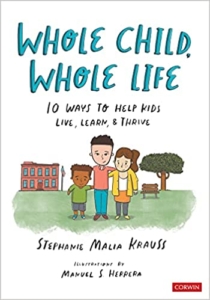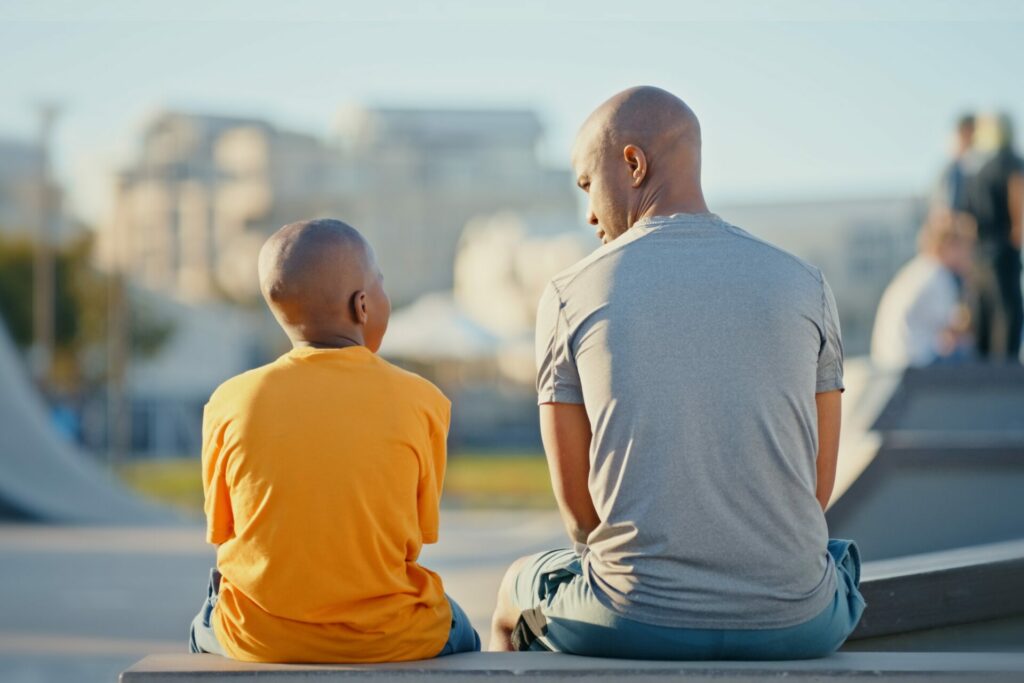We’re entrusted with the sacred responsibility of taking care of these kids and we need to equip them with life-giving and life-extending practices so they’re prepared for the future.
Stephanie Malia Krauss, Author, “Whole Child, Whole Life”
Stephanie Malia Krauss is a New Jersey native and proud GED recipient. She is currently a mom of two school-aged boys living in St. Louis, Missouri. On her journey, she has been a teacher, social worker, coach, and even ran Missouri’s first and only competency-based high school. For the past decade, Stephanie has worked nationally on education, youth development, and higher education initiatives. We sat down with Stephanie to discuss her new book Whole Child, Whole Life: 10 Ways to Help Kids Live, Learn, and Thrive.
 Q: What need did you see in the world that inspired you to write this book?
Q: What need did you see in the world that inspired you to write this book?
Stephanie: My first book is called Making It: What Today’s Kids Need for Tomorrow’s World. That book was about what kids need to be ready for the future. It came out at the height of the pandemic when the idea of the future felt very far away and disconnected from the pressing needs of what kids were facing. I wanted to explore what young people need to be ready for a world that is unfair and unjust.
Every time I would talk about the book, somebody would say, “I appreciate that you’re telling me about what kids need to be ready for the future, but I’m worried my kid or the kids I work with are going to give up or burnout before they get there. What do they need right now?”
I noticed two things. One, as a mom, this was a question I was also asking myself. I wondered if it was possible for my kids to live and love their lives even when things are really hard. What can we do to make sure that they’re okay now?
Two, I wondered if it is possible to figure out what supports young people need now that they can also rely on for the rest of their lives, learning skills that would be beneficial for a lifetime. I recognized that based on my professional connections and training across education, social work, workforce development, higher education, and human services, I actually knew the people and I had the research that might be able to answer the question of what kids need to thrive, even in challenging and changing times.
And so, that’s what I went after. I think this book differs from others because it’s really clear-eyed about the challenges kids face and the hardships they go through. Adults need to grieve and get over that reality. They need to accept that this is how kids are growing up. We all talk about the importance of lifelong learning, but I really wanted to explore what is required for lifelong thriving. I wanted to shift the goal from college and career readiness to helping kids build livable lives they love.
Q: Why was it important for you to begin the book with a focus on the whole child portrait—mind, body, and social interactions?
Stephanie: I think language and context matter so much. When we call kids students, athletes, or clients, we inadvertently strip them of the parts of who they are and what makes them young humans. They are not compartmentalizing themselves. They’re bringing their whole selves into school, community settings, camp, the field, the stage—all of their past, their feelings, and how their day was, all come with them. They identify as themselves.
I think about my fourth-grade son, Harrison. If his teacher Mr. Maclin were to ever say, “Harrison, you’re just my student,” it would crush him. Or if your supervisor said to you, “You’re just my employee,” you would feel so devalued. We can feel the reduction when we frame it that way.
We need to recognize that whenever a kid is with us, their whole self is in our care. We have a responsibility to steward the space and create the conditions where they can thrive. And thriving has particular characteristics, including kids being able to have joy and purpose. To learn and grow. To be healthy, safe, and connected. Those are the kind of indicators I talk about in the book.
In education, we talk about the “whole child” as a phrase, but that still feels a little bit reductionist to me. A lot of those conversations just talk about the individual parts of a kid. We don’t consider the context. I think we really need to cross-train ourselves to consider the whole of who a kid is and the whole of what might be going on when they come into our classroom or into relationship with us. And so, I start the book with that concept.
I worked with an amazing illustrator, Manuel Herrera, who was a special education teacher and is a skilled artist and sketchnoter. Throughout the book, the illustrations of three characters start as rough sketches and become increasingly textured and more detailed in each chapter. The idea is that we think we know kids based on where they live or who shows up for them or what the data tells us. But that view of them can be harmful and loaded with assumptions. As we go through the book and the reader explores what kids need and who they are as young people, the images become more defined, and you see a fuller picture of who that kid is—developmentally, cognitively, socially, emotionally, even spiritually and health-wise.
When I think of what it means to enable and encourage a kid to live, learn, and thrive, I’m thinking about their well-being and their well-becoming.
Stephanie Malia Krauss, Author, “Whole Child, Whole Life”
Q: The book explores the idea of 10 Whole Life Practices, including investing in personal interests and being a force for good. How do you see the vision of learner-centered ecosystems embodying some or all of these practices?
Stephanie: When we truly put kids at the center, it depoliticizes the conversation because we’re talking about the livelihoods of the young people themselves. We’re asking questions like: What does it take to learn? What does it take to develop? What does it take to be well? We’re entrusted with the sacred responsibility of taking care of these kids, and we need to equip them with life-giving and life-extending practices so they’re prepared for the future.
The 10 Whole Life Practices reflect the science of what young people need and step outside of prescriptive programs. I wanted to offer a perspective that where learning happens is actually less important than what is happening in the environment and in the experience. We want to create the conditions that are optimal for learning and thriving. I think these elements can be strongly embodied in a learner-centered ecosystem, and I encourage everybody to see how they can incorporate these practices right now—in public schooling, private schooling, homeschooling, unschooling, reschooling, or however school looks to their young people.
The question is, can you set up the characteristics to support a young person’s ability to be safe, healthy, grounded, joyful, purposeful, learning, and growing? Kids are asking themselves questions like: Who am I? Where do I belong? Who are my people? It’s a central part of growing up, becoming a teen, and even continues into and through adulthood. We want to make sure they have the ability to answer these questions and know who they are.
Q: Which of the 10 Whole Life Practices has been the most transformational for your family?
Stephanie: I have two answers for you! The first is prioritizing mental health. I think we’re just beginning to see the extent of the youth mental health crisis we are in, and I don’t think it’s getting better anytime soon. I believe my kids, and all kids, will likely struggle with their mental health at some point in their lifetime. I see it as my job to prepare them to be okay now and in the future, making sure they know what to watch out for, what could come up, and what to do about it, as well as to know it is part of the journey.
I grew up swimming competitively and learned many techniques to perfect my stroke. I carry those skills with me to this day. When I’m swimming at my local pool, people recognize those skills I acquired years ago. In a similar way, we can equip kids with the skills and knowledge to care for their mental health so they can attend to it when and if the time comes.
The second is embracing identities and cultures. We are fair-skinned native Hawaiians. While writing this book, I got to take my boys to Hawai?i for the first time. We had an opportunity to be immersed in our culture, language, and even the food at the grocery store! They were able to be with friends, family, and an environment that we’re deeply rooted in.
I learned that much of my welfare is bound up in my boys’ welfare as well, so it was amazing to watch them come alive and explore parts of who they are. There was a real mutual thriving. Something that was really transformative was seeing how we were walking through life here in the Midwest, not even realizing that we were missing a piece of ourselves until we got to Hawai?i.
Q: As you close the book, you bring all the pieces together and explore how to aim for wholeness. Can you share one or two strategies caregivers, educators, or mentors can take to begin this process today?
Stephanie: When I think of what it means to enable and encourage a kid to live, learn, and thrive, I’m thinking about their well-being and their well-becoming. As you move through the world, can you be the whole of yourself? Can you have this life worth living where you can bring your full self into spaces to learn and grow?
When we think about strategies for adults, the first is a deeply reflective and self-appraising one. There’s a lot of information in this book because the manual for taking care of living, breathing, complex, unique humans is absolutely going to be the most complicated thing we can come up with. It’s important to make a commitment to being a learner yourself—to be humble and honest about the pieces you still need to learn. I encourage everyone to become a specialist in the science and art of taking care of kids, not just one aspect related to instructing, counseling, or coaching them. The book gives a really full overview, but there are opportunities to go deeper on topics that intrigue you or that you want to learn more about. There are plenty of suggestions for additional resources.
I also think it’s important to do a loose inventory of the spaces we create or advocate for as they relate to the kids you’re working with, raising, or both. By doing that, you can quickly see if the 10 Whole Life Practices are being met in those spaces. Are kids? mental health needs being prioritized? Do they feel like they belong? Do they have healthy relationships? If any needs aren’t being met, think about how those needs can be met, either through opportunities you provide or resources you suggest. If I’m truly centered on the learner, all ten of those practices should be lighting up in various places across their learning ecosystems.
Stephanie is a longtime friend of Education Reimagined and would love to partner and work with you. If you’d like to use her book as a book study or find it valuable to your work, please contact her. Whole Child, Whole Life: 10 Ways to Help Kids Live, Learn, and Thrive is available now.

